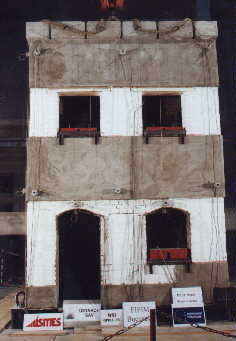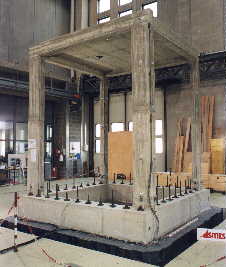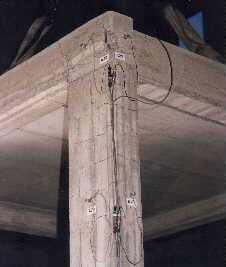
Experimental evaluation of technical interventions to reduce seismic vulnerability of old existing buildings
The purpose of the research project was to analyse seismic resistance of old, monumental brick masonry buildings. For this purpose a scaled (1:2), heavy (22 tons) model was designed and subjected to a series of tests on shaking table. The sequence of time history excitations started from 0.27 m/s^2 PGA (Peak Ground Acceleration). The tests were repeated with increasing intensity until the level of 3.68 m/s^2 PGA was reached. At this stage the model was substantially damaged but still possible to repaire. Next the model was retrofitted using special fibre plaster belts with synthetic grid in the upper part of the model (two upper belts) and steel grids in the lower part and inside of the model. The retrofitted model was subjected to seismic tests again, this time reaching 6.95 m/s^2 PGA before substantial damage was observed. This research was funded by Grant of the European Commission (DG XII Science, Research, & Development in framework of Environmental PECO studies, project CT930060). Main partners actively involved in the project: ICA SAS Bratislava, Slovakia, (E. Juhásová, M. Hurák, M. Juhás), ISMES Bergamo-Seriate, Italy, (P. Pezzoli, E.M. DaRin), coordinator, University of Bucharest, Romania, (R. Sofronie, G. Popa), Technical University of Opole, Poland, (Z. Zembaty, M. Kowalski)

Scaled model of brick masonry building after retrofitting and second sequence of seismic tests
Damage estimation using dynamic excitation
The purpose of this research was to study the effects of the presence of cracks on dynamic parameters (natural periods, mode shapes and damping ratios) of a reinforced concrete frame. The frame was subjected to series of time history tests with increasing intensities. Each stage of damaging excitations was followed by various low level excitations to asses the dynamic characterisitics of the r/c frame. The project was sponsored by the European Community action: TMR Program, carried out at ISMES, Bergamo, Italy in 1998 and supported by Action 2, Access to large scale facilities. Following main partners took part in the experiment: Institute of Structural Mechanics, Wuppertal University (Hans Giese, Andreas Kayser), Institute of Theoretical and Applied Mechanics, CAS, Prague, Czech Republic (Stanislav Pospisil, Shota Urushadze) and Faculty of Civil Engineering, Technical University of Opole, Poland (Zbigniew Zembaty, Marcin Kowalski).
Reinforced concrete frame on shaking table, before damaging tests

Detail of the reinforced concrete frame after damage